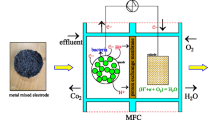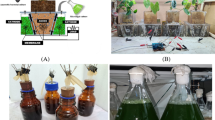Abstract
Cathode activity plays an important role in the improvement of the microbial fuel cells on ocean floor (BMFCs). A comparison study between Rayon-based (CF-R) and PAN-based carbon fiber (CF-P) cathodes is conducted in the paper. The two carbon fibers were heat treated to improve cell performance (CF-R-H & CF-P-H), and were used to build a new BMFCs structure with a foamy carbon anode. The maximum power density was 112.4 mW m−2 for CF-R-H, followed by 66.6 mW m−2 for CF-R, 49.7 mW m−2 for CF-P-H and 21.6 mW m−2 for CF-P respectively. The higher specific area and deep groove make CF-R have a better power output than with CF-P. Meanwhile, heat treatment of carbon fiber can improve cell power, nearly two-fold higher than heat treatment of plain fiber. This improvement may be due to the quinones group formation to accelerate the reduction of oxygen and electron transfer on the fiber surface in the three phase boundary after heat treatment. Compared to PAN-based carbon fiber, Rayon-based carbon fiber would be preferentially selected as cathode in novel BMFCs design due to its high surface area, low cost and higher power. The comparison research is significant for cathode material selection and cell design.
Similar content being viewed by others
References
Berk, R. S., and Canfield, J. H., 1964. Bioelectrochemical energy conversion. Applied and Environmental Microbiology, 12: 10–12.
Rao, J. R., Richter, G. J., Von Sturm, F., and Weidlich, E., 1976. The performance of glucose electrodes and the characteristics of different biofuel cell constructions. Bioelectrochemistry and Bioenergetics, 3: 139–150.
Davis, J. B., and Yarbrough, H. F., 1962. Preliminary experiments on a microbial fuel cell. Science, 137: 615–616.
Higgins, S. R., Foerster, D., Cheung, A., Lau, C., Bretschger, O., Minteer, S. D., Nealson, K., Atanassov, P., and Cooney, M. J., 2011. Fabrication of macroporous chitosan scaffolds doped with carbon nanotubes and their characterization in microbial fuel cell operation. Enzyme and Microbial Technology, 48: 458–465.
Nimje, V. R., Chen, C.Y., Chen, H. R., Chen, C. C., Huang, Y. M., Tseng, M. J., Cheng, K. C., and Chang, Y. F., 2012. Comparative bioelectricity production from various wastewaters in microbialfuelcells using mixed cultures and a pure strain of Shewanella oneidensis. Bioresource Technology, 104: 315–323.
Cheng, S. A., Liu, H., and Logan, B. E., 2006. Power densities using different cathode catalysts (Pt and CoTMPP) and polymer binders (Nafion and PTFE) in single chamber microbial fuel cells. Environmental Science and Technology, 40: 364–369.
Fu, Y. B., Zhao, Z. K., Liu, J., Li, K. Z., Xu, Q., and Zhang, S. Y., 2011. Sulfonated polyaniline/vanadate composite as anode material and its electrochemical property in microbial fuel cells on ocean floor. Science China Chemistry, 54: 844–849.
Lowy, D. A., and Tender, L. M., 2008. Harvesting energy from the marine sediment-water interface III Kinetic activity of quinone and antimony-based anode materials. Journal of Power Sources, 185: 70–75.
Niessen, J., Schroder, U., Rosenbaum, M., and Scholz, F., 2004. Fluorinated polyanilines as superior materials for electro-catalytic anodes in bacterial fuel cells. Electrochemistry Communications, 6: 571–575.
Rhoads, A., Beyenal, H., and Lewandowski, Z., 2005. Microbial fuel cell using anaerobic respiration as an anodic reaction and biomineralized manganese as a cathodic reactant. Environ- mental Science and Technology, 39: 4666–4671.
Zhao, F., Harnisch, F., Schroeder, U., Scholz, F., Bogdanoff, P., and Herrmann, I., 2006. Challenges and constraints of using oxygen cathodes inmicrobial fuel cells. Environmental Science and Technology, 40: 5193–5199.
Clauwaert, P., Ha, D. V. D., Boon, N., Verbeken, K., Verhaege, Rabaey, M. K., and Veratraete, W., 2007. Open air biocathode enables effective electricity generation with microbial fuel cells. Environmental Science and Technology, 41: 7564–7569.
Zhao, F., Rahunen, N., Varcoe, J. R., Chandra, A., Avignone-Rossa, C., Thumser, A. E., and Slade, R. C. T., 2008. Activated carbon cloth as anode for sulfate removal in a microbial fuel cell. Environmental Science and Technology, 42: 4971–4976.
Wei, J. C., Liang, P., and Huang, X., 2011. Recent progress in electrodes for microbial fuel cells. Bioresource Technology, 102: 9335–9344.
Yanga, H., Tub, H. C., and Chiang, I. L., 2010. Carbon cloth based on PAN carbon fiber practicability for PEMFC applications. International Journal of Hydrogen Energy, 35: 2791–2795.
Hasvold, O., Henriksen, H., Melvaer, E., Citi, G., Johansen, B. O., Kjonigsen, T., Galetti, R., 1997. Sea-water battery for subsea control systems. Journal of Power Sources, 65: 253–261.
Wang, L. Y., Yang, C. L., Lu, Y. G., Liu, X., and Zhang, Y. X., 2010. Effect of electrochemical treatment on surface characters of PAN-based carbon fibers. Aerospace Materials Technology, 3: 51–54.
Kazuya, W., 2008. Recent developments in microbial fuel cell technologies for sustainable bioenergy. Journal of Bioscience and Bioengineering, 106: 528–536.
Gunther, G. S., 1997. Interfacial aspects in the development of polymer electrolyte fuel cells. Solid State Ionics, 94: 249–257.
Xu, H. F., Han, M., and Yi, B. L., 1999. Cathode mathematical model of proton exchange membrane fuel cell. Journal of Power Sources, 23: 312–315.
Wang, X., Cheng, S. A., Feng, Y. J., Merrill, M. D., Saito, T., and Logan, B. E., 2009. Use of carbon mesh anodes and the effect of different pretreatment methods on power production in microbial fuel cells. Environmental Science and Technology, 43: 6870–6874.
Fenga, Y. J., Yanga, Q., Wanga, X., and Logan, B. E., 2010. Treatment of carbon fiber brush anodes for improving power generation in air-cathode microbial fuel cells. Journal of Power Sources, 195: 1841–1844.
Freguia, S., Masuda, M., Tsujimura, S., and Kano, K., 2009. Lactococcus lactis catalyses electricity generation at micro- bial fuel cell anodes via excretion of a soluble quinone. Bioelectrochemistry, 76: 14–18.
Author information
Authors and Affiliations
Corresponding author
Rights and permissions
About this article
Cite this article
Fu, Y., Liu, Y., Xu, Q. et al. Comparative study of two carbon fiber cathodes and theoretical analysis in microbial fuel cells on ocean floor. J. Ocean Univ. China 13, 257–261 (2014). https://doi.org/10.1007/s11802-014-2162-z
Received:
Revised:
Accepted:
Published:
Issue Date:
DOI: https://doi.org/10.1007/s11802-014-2162-z




